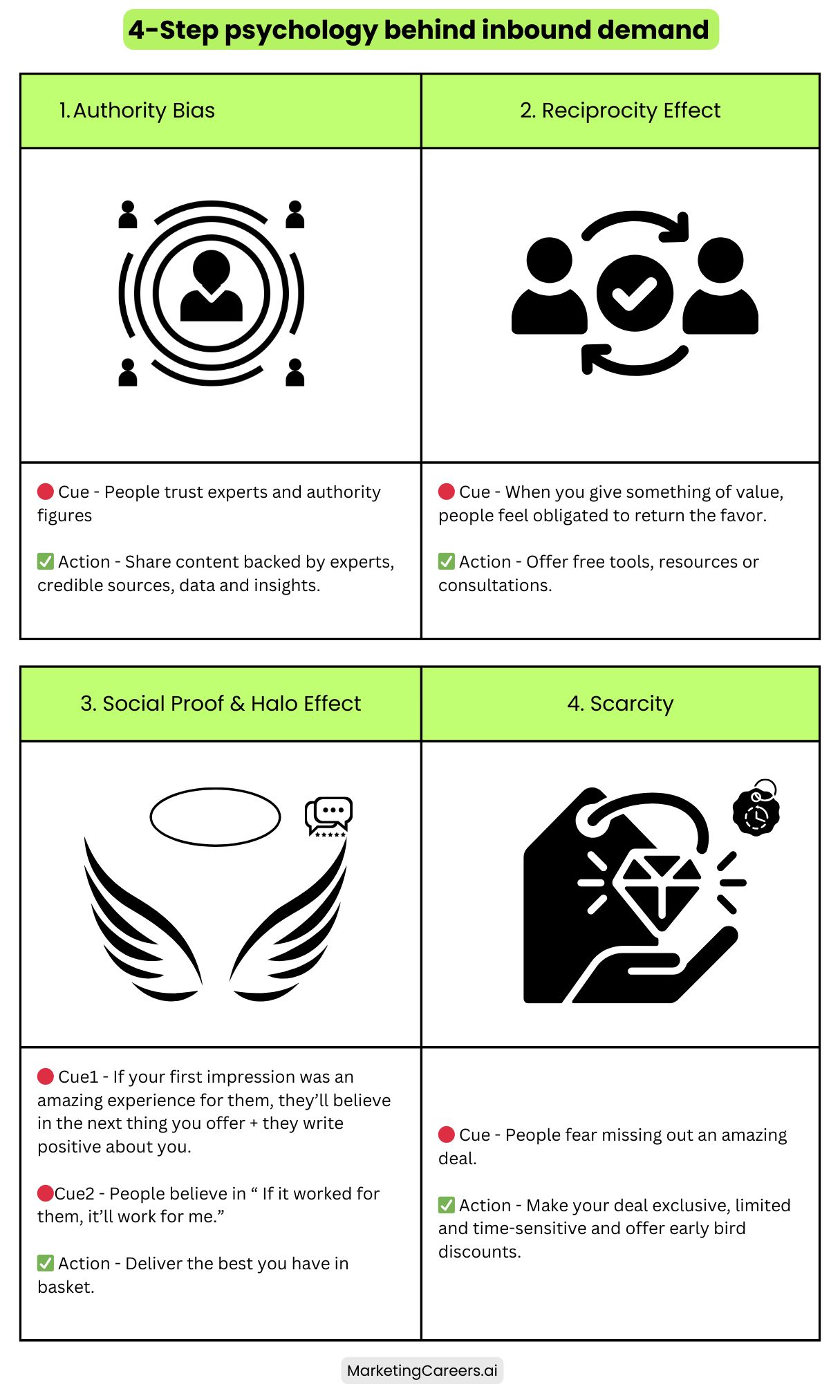

Table of Contents
Curated Careers
Trends and Tidbits:
Inbound Marketing vs. Demand Generation, what’s the difference?
4-step Psychology Behind Inbound Demand
If this was forwarded to you, consider joining our community through this link.

In the ever-evolving landscape of digital marketing, the pressure to keep pace with algorithm updates, consumer behaviour analytics, and data-driven decision-making is more intense than ever.
With marketers facing the constant challenge of mastering SEO shifts, leveraging AI for predictive insights, and optimising multi-channel campaigns, the need to upskill has never been more crucial.
The ISB Executive Education's Digital Marketing and Analytics Programme empowers professionals with advanced skills in analytics, AI-integrated digital marketing strategies, and hands-on experience with industry-standard tools and case studies.
Stay ahead of the curve by learning the latest digital marketing techniques tailored for today’s data-driven world.
For queries on the programme, you can write to [email protected]
💼 Curated Careers 💼
Marketing Automation Manager at Prefect
📍 Full-time, Remote
⚒️ Brief: Your number one goal will be to ensure leads are created from the channels we deem important like product signups, community engagement, social engagement, Github, etc.
Marketing Campaign Coordinator at Borrowell
📍 Full-time, Remote
⚒️ Brief: Using a combination of data-driven decision-making and creativity, propose experiments and campaigns that will unlock growth and give us learnings.
X (Twitter) Marketing Manager at Bunny Agency LLC
💎 Trendy Tidbits 💎
➡️ WTH is Inbound Marketing?

Back in 2007, Moz was a small startup offering SEO services and tools.
But, Moz did something different with its marketing part.
People at Moz didn’t go for search ads or guest posts.
They simply started creating educational content on how a search engine works.
And how someone can harness the real power of browser search.
→ Meanwhile, they also soft-sold their SEO tools.
From blogs to webinars, free tools, and a rich user forum, Moz became a hub for SEO enthusiasts.
People came for the content and stayed for the tools.
So, what do we learn from this case? What is inbound marketing?
It is nothing but attracting your customers by creating valuable content and experiences specifically for those who are looking for it.
But, it’s done in a more strategic and connected manner.
➡️Outbound vs. Inbound Marketing
Simplifying even more, there are two ways you can reach your potential customers.
1️⃣ Fight for their attention through ads or cold emails. Just like shouting your message to everyone, hoping someone hears. (that’s outbound)
2️⃣ Create educational content, engaging stories, and helpful resources. It’s like a magnet that pulls customers toward your brand. (that’s inbound)
By providing free value upfront, Moz didn’t just generate leads. It created a new lead generation engine by developing a loyal, engaged audience. Who don’t just do business with them, but also learn from their content.
➡️Inbound Marketing vs. Inbound Demand Generation
Inbound marketing, Initially a term coined by HubSpot, is now a leading B2B marketing strategy.
The philosophy is to capture the already existing demand in the market, targeting a small percentage of potential buyers who are looking for a solution at a given time.
🔴But there are three big issues with that!
1️⃣ For any product or service market, 95% of your market isn’t actively looking for a solution.
→ So, you must create the demand✅
How? Distribute your content through different channels—
i) Blog posts, ii) Ebooks, iii) YouTube explainer videos, iv) Social media, v) Search engine optimization, vi) Email list, vii) Webinars and events
2️⃣ People don’t want to become leads
Lead generation using inbound marketing has become ineffective in recent times. here’s why—
→ You capture the contact details to generate a database of leads.
↳ which are then scored, nurtured, and contacted by your sales team
↳ But the buyer has learned that if they hand over their contact details, it leads to receiving things they hate! (spam, salesy emails, aggressive promotions)

Giphy
3️⃣ Buyer journeys are more complex than you think
Traditional inbound marketing suggests a linear buyer journey pathway.
↳ Pain/ Problem Aware→ Solution Aware→ Provider Aware
Thus based on the linear path, the content can be distributed as per the below linear map.
↳ TOFU (Top of the funnel)→ MOFU (Middle of the funnel)→ BOFU (Bottom of the funnel)
But today’s buyers don’t fall into the linear path. The buyer’s actions are wildly unpredictable. That’s where the necessity of Behavioral Analytics comes in.
And above 3 reasons lead to adopting inbound demand generation.
Many people confuse inbound marketing with inbound demand generation, but these two are not quite the same.
Inbound marketing primarily focuses on pulling the leads through valuable content and nurturing them along the buyer’s journey.
Inbound demand generation, on the other hand, isn’t just about filling the top of the funnel. It’s about generating intent from potential buyers.
↳ then building a pipeline of qualified prospects who are ready to engage with your product or service.
Most of the time, both tactics work hand-in-hand, but inbound demand generation takes it a step further by using psychology, data, and deep insights to create desire and a sense of genuine need in the customer’s mind.

When speaking about genuine need, you must understand only genuine content will reciprocate with genuine need.
➡️Why posting only promotional content doesn’t lead to Inbound Demand
One huge mistake that many brands do is continuously writing promotional content but assuming that it must be helping someone.
They think simply posting about their product will create a desire for it.
🔦Reality check: People don’t like being sold to!
As Pierre Herubel said, the buyer’s eyes work like radar. They know what is value and what is spam.

✅Learn how to balance education and persuasion.
Think about it: Moz didn’t just blog about SEO. They created tools, offered in-depth courses, and built a community — all while subtly nudging their audience toward their paid services.
🔴Create the attraction effect in your content—
Whenever you try to persuade your audience, trust is the x-factor. To create trust and reciprocity, your content should revolve around—
1- Solving real problems. [ Don’t just list your features, but compare it with another brand that provides less impressive results with similar pricing]
2- Sharing success stories and case studies.
3- Offering free resources.
➡️The 4-Step Psychology Behind Inbound Demand

And that marks a wrap on the basics of inbound marketing and demand generation with the psychology behind it.🥙
Stay tuned for ‘The Complete Inbound Demand Generation’ playbook which I’ll share in the next letter.
In other thoughts…
Daily News for Curious Minds
Be the smartest person in the room by reading 1440! Dive into 1440, where 4 million Americans find their daily, fact-based news fix. We navigate through 100+ sources to deliver a comprehensive roundup from every corner of the internet – politics, global events, business, and culture, all in a quick, 5-minute newsletter. It's completely free and devoid of bias or political influence, ensuring you get the facts straight. Subscribe to 1440 today.
🤖 AI Arena 🤖
➡️Product Description GPT
This prompt helps you write and improve your product descriptions.
You have to fill in the space-holders, add an image of your product, and prompt it to ChatGPT. It writes a product description just like a professional copywriter would.
Here’s one we tried for a product with an image attached.
Prompt:
Act like a professional product copywriter with expertise in creating highly persuasive, SEO-optimized product descriptions that drive conversions. Your task is to write a compelling product description based on the following details:
Product Name: [Insert the name of the product]
Product Category: [Insert product category, e.g., electronics, fashion, home decor]
Target Audience: [Insert specific target audience, e.g., tech-savvy professionals, fitness enthusiasts, busy parents]
Key Features: [List the main features of the product]
Benefits: [Describe the most important benefits the customer will experience]
Unique Selling Proposition (USP): [What makes this product stand out from competitors?]
Usage Scenarios: [Provide examples of when or how the product is typically used]
Tone of Description: [Insert the desired tone, e.g., professional, friendly, luxurious]
Call to Action (CTA): [Insert the action you want the reader to take, e.g., “Shop now,” “Add to cart,” “Order today”]
Product Description Structure:
Engaging Introduction: Start with an attention-grabbing sentence that instantly captures the reader’s interest. Appeal to their emotions or highlight a major benefit of the product.
Key Features and Benefits: Outline the main features of the product in a clear and compelling way. Pair each feature with a tangible benefit to show why it matters to the customer.
Unique Selling Proposition (USP): Briefly explain what sets this product apart from others in the market. Focus on its uniqueness and why it’s the best choice for the target audience.
Usage Scenarios: Describe how and when the product can be used. This helps the customer envision themselves benefiting from the product in their daily life.
Call to Action (CTA): Conclude with a strong CTA that motivates the reader to take immediate action, whether it’s making a purchase or learning more about the product.
Write this product description with attention to detail and ensure that it is tailored to the target audience’s needs and preferences.
Take a deep breath and work on this problem step-by-step.
🧠AI tool-picks of the week🧠
1) Waymark - Helps to create compelling video ads and commercial-spec spots in minutes (link)
2) Equals - A next-generation spreadsheet that seamlessly connects to your data sources and automates reporting, analysis, and insights (link)
3) Locofy.ai - A low-code platform that allows you to convert your designs into production-ready frontend code, saving 80-90% of your development time (link)
🧠Interesting reads🧠
🔗Write “10” not “ten” → Ariyh
🔗 LinkedIn Playbook by Bren Kinfa → Link
🔗 Hugging Face lets you try what’s next in AI → Link
🔗Build your dream website in minutes: top 5 no-code AI builders → Link
🔗Google DeepMind is redefining AI problem-solving with transformers → Link
Did you enjoy this issue?

Thanks,
Deep Kakkad, your marketer friend.
